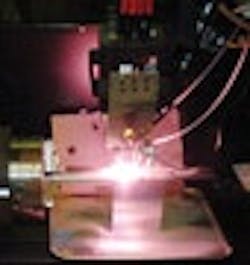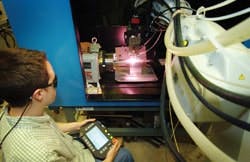New Manufacturing Technique Perfected
Researchers at Purdue University are perfecting a technique for manufacturing parts that have complex shapes and precision internal features by depositing layers of powdered materials, melting the powder with a laser and then immediately machining each layer.
The new method can be used for creating parts made of advanced materials such as ceramics, which are difficult to manufacture and cannot be machined without first using a laser to soften the material, says Yung Shin, professor of mechanical engineering and director of Purdue's Center for Laser-Based Manufacturing. Shin worked at the General Motors Tech Center in Michigan before beginning his now 17 years at Purdue.
Hitting the Mark
Mechanical engineering doctoral student Kevin Schoeffel controls a laser-cladding system at Purdue University.
Photograph courtesy of Purdue News Service/David Umberger
Although the basic laser deposition technique is not new, the Purdue researchers have increased its precision by adding the machining step.
Weve improved the method--so that its about 20 times more accurate--by adding the ability to machine the part while it is being formed, says Shin. We have developed a facility that actually can deposit the powder, heat it with the laser and machine it at the same time.
The new technique could be critical for manufacturing certain kinds of ceramic components that are not produced in large enough quantities to justify the expense of designing costly dies. Components made in small lot sizes might be produced far more economically by machining instead of using dies. But there has been no practical way to machine the brittle ceramic materials economically with the high precision needed for many applications.
Under Control
The integrated laser deposition and machining system consists of a custom-designed, five-axis gantry system, a high-speed spindle, a Nd:YAG crystal laser, a powder feeder and a deposition nozzle. The entire system, including laser power and machining spindle speed, is controlled via Aerotech A3200 controller and software. The scanning path of the laser beam is designed using CAM software.
Purdues research program is one of a handful of efforts internationally to develop such a system, which could be used to produce small quantities of parts faster than currently possible, says Shin. From start to finish, beginning with just a design, we can have the job completed in a couple of days, compared to several weeks for a conventional manufacturing operation, he says.
Researchers at the Purdue center are able to precisely control the power and temperature of the laser and have developed mathematical models for the procedure, steps critical for the technologys practical application. The researchers also created a graphical user interface for the techniques software.
Laser deposition has been used commercially to create parts that have complex shapes, such as gun barrels, jet engine turbine components, spare parts for various military equipment, connecting rods for engines, automotive brake components, synthetic teeth, artificial knee joints and next-generation computer memory devices. However, with current laser deposition, the part is machined after it is completely formed, meaning the technique cannot be used to create accurate internal features, and it is mostly limited to manufacturing metal parts, says Shin.
But this integrated process can be used for fabricating ceramic parts as well, and parts that have internal features, says Shin. This is important because advanced ceramics are exceptionally hard, can withstand high temperatures and do not wear out as quickly as metals.
Technique With Legs
The technique is potentially practical for industry because it does not require expensive clean-room environments. We have a provisional patent approved, explains Shin. Were trying to find a company that can commercialize this. Were in academia, so we dont do the commercialization ourselves. There are some companies that have signed the confidentiality agreements to look at commercializing this.
Rolls-Royce is evaluating the machining method for potential medium and long-range applications, says W. Parker Sykes, the company's chief consultant for advanced manufacturing.
Shins group also is developing a monitoring system for the deposit layer height and the weld pool. These are very important to maintain the quality of the part, explains Shin. We have done some evaluation using a CCD camera with an auxiliary layer. For the monitoring, we are developing ENOS capabilities with LabView. Were trying to improve the laser accuracy deposition by a factor of 20, so we can make accurate parts that people can use.


